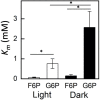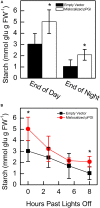Phosphoglucoisomerase Is an Important Regulatory Enzyme in Partitioning Carbon out of the Calvin-Benson Cycle
- PMID: 33362810
- PMCID: PMC7758399
- DOI: 10.3389/fpls.2020.580726
Phosphoglucoisomerase Is an Important Regulatory Enzyme in Partitioning Carbon out of the Calvin-Benson Cycle
Abstract
Phosphoglucoisomerase (PGI) isomerizes fructose 6-phosphate (F6P) and glucose 6-phosphate (G6P) in starch and sucrose biosynthesis. Both plastidic and cytosolic isoforms are found in plant leaves. Using recombinant enzymes and isolated chloroplasts, we have characterized the plastidic and cytosolic isoforms of PGI. We have found that the Arabidopsis plastidic PGI K m for G6P is three-fold greater compared to that for F6P and that erythrose 4-phosphate is a key regulator of PGI activity. Additionally, the K m of spinach plastidic PGI can be dynamically regulated in the dark compared to the light and increases by 200% in the dark. We also found that targeting Arabidopsis cytosolic PGI into plastids of Nicotiana tabacum disrupts starch accumulation and degradation. Our results, in combination with the observation that plastidic PGI is not in equilibrium, indicates that PGI is an important regulatory enzyme that restricts flow and acts as a one-way valve preventing backflow of G6P into the Calvin-Benson cycle. We propose the PGI may be manipulated to improve flow of carbon to desired targets of biotechnology.
Keywords: Calvin-Benson cycle; carbon partitioning; erythrose 4-phosphate; phosphoglucoisomerase; starch.
Copyright © 2020 Preiser, Banerjee, Weise, Renna, Brandizzi and Sharkey.
Conflict of interest statement
The authors declare that the research was conducted in the absence of any commercial or financial relationships that could be construed as a potential conflict of interest.
Figures





Similar articles
-
Plastidic phosphoglucose isomerase is an important determinant of starch accumulation in mesophyll cells, growth, photosynthetic capacity, and biosynthesis of plastidic cytokinins in Arabidopsis.PLoS One. 2015 Mar 26;10(3):e0119641. doi: 10.1371/journal.pone.0119641. eCollection 2015. PLoS One. 2015. PMID: 25811607 Free PMC article.
-
The oxidative pentose phosphate pathway in photosynthesis: a tale of two shunts.New Phytol. 2024 Jun;242(6):2453-2463. doi: 10.1111/nph.19730. Epub 2024 Apr 3. New Phytol. 2024. PMID: 38567702
-
Engineering of the cytosolic form of phosphoglucose isomerase into chloroplasts improves plant photosynthesis and biomass.New Phytol. 2021 Jul;231(1):315-325. doi: 10.1111/nph.17368. Epub 2021 May 2. New Phytol. 2021. PMID: 33774822
-
Dark complexes of the Calvin-Benson cycle in a physiological perspective.Semin Cell Dev Biol. 2024 Mar 1;155(Pt A):48-58. doi: 10.1016/j.semcdb.2023.03.002. Epub 2023 Mar 6. Semin Cell Dev Biol. 2024. PMID: 36889996 Review.
-
Mechanisms controlling metabolite concentrations of the Calvin Benson Cycle.Semin Cell Dev Biol. 2024 Mar 1;155(Pt A):3-9. doi: 10.1016/j.semcdb.2023.02.009. Epub 2023 Feb 28. Semin Cell Dev Biol. 2024. PMID: 36858897 Review.
Cited by
-
Reimport of carbon from cytosolic and vacuolar sugar pools into the Calvin-Benson cycle explains photosynthesis labeling anomalies.Proc Natl Acad Sci U S A. 2022 Mar 15;119(11):e2121531119. doi: 10.1073/pnas.2121531119. Epub 2022 Mar 8. Proc Natl Acad Sci U S A. 2022. PMID: 35259011 Free PMC article.
-
Chloroplast Functionality at the Interface of Growth, Defense, and Genetic Innovation: A Multi-Omics and Technological Perspective.Plants (Basel). 2025 Mar 20;14(6):978. doi: 10.3390/plants14060978. Plants (Basel). 2025. PMID: 40265935 Free PMC article. Review.
-
The effect of circular soil biosolarization treatment on the physiology, metabolomics, and microbiome of tomato plants under certain abiotic stresses.Front Plant Sci. 2022 Nov 8;13:1009956. doi: 10.3389/fpls.2022.1009956. eCollection 2022. Front Plant Sci. 2022. PMID: 36426148 Free PMC article.
-
Two opposing redox signals mediated by 2-cys peroxiredoxin shape the redox proteome during photosynthetic induction.Redox Biol. 2025 Aug 5;86:103810. doi: 10.1016/j.redox.2025.103810. Online ahead of print. Redox Biol. 2025. PMID: 40795616 Free PMC article.
-
Cytosolic phosphoglucose isomerase is essential for microsporogenesis and embryogenesis in Arabidopsis.Plant Physiol. 2023 Jan 2;191(1):177-198. doi: 10.1093/plphys/kiac494. Plant Physiol. 2023. PMID: 36271861 Free PMC article.
References
-
- Abiri R., Valdiani A., Maziah M., Azmi Shaharuddin N., Sahebi M., Norhana Balia Yusof Z., et al. (2016). A critical review of the concept of transgenic plants: insights into pharmaceutical biotechnology and molecular farming. Curr. Issues Mol. Biol. 18 21–42. - PubMed
-
- Alberty R. A. (1953). The relationship between Michaelis constants, maximum velocities and the equilibrium constant for an enzyme-catalyzed reaction. J. Am. Chem. Soc. 75 1928–1932. 10.1021/ja01104a045 - DOI
-
- Ausich R. L. (2009). Commercial opportunities for carotenoid production by biotechnology. Pure Appl. Chem. 69 2169–2173. 10.1351/pac199769102169 - DOI
-
- Backhausen J. E., Jöstingmeyer P., Scheibe R. (1997). Competitive inhibition of spinach leaf phosphoglucose isomerase isoenzymes by erythrose 4-phosphate. Plant Sci. 130 121–131. 10.1016/s0168-9452(97)00208-202 - DOI
-
- Bahaji A., Sánchez-López ÁM., De Diego N., Muñoz F. J., Baroja-Fernández E., Li J., et al. (2015). Plastidic phosphoglucose isomerase is an important determinant of starch accumulation in mesophyll cells, growth, photosynthetic capacity, and biosynthesis of plastidic cytokinins in Arabidopsis. PLoS One 10:e0119641. 10.1371/journal.pone.0119641 - DOI - PMC - PubMed
Grants and funding
LinkOut - more resources
Full Text Sources
Molecular Biology Databases

